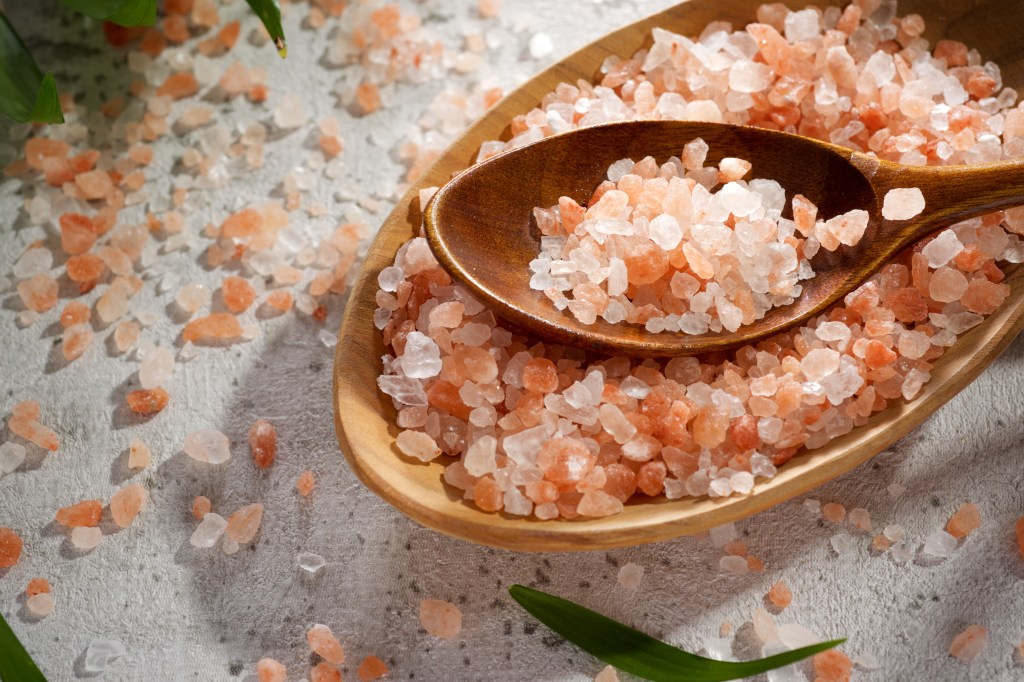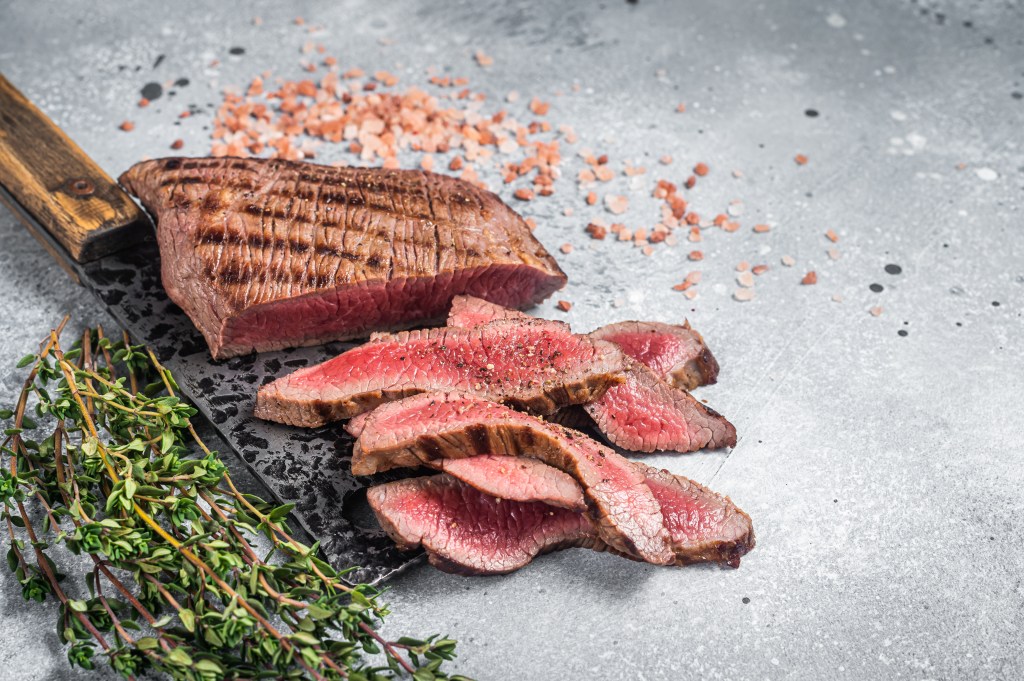At a glance
Himalayan pink salt and sea salt both provide minerals that support health. However, Himalayan salt is sourced from ancient deposits, while sea salt is obtained from modern ocean sources. Because Himalayan pink salt contains fewer contaminants, undergoes minimal processing, and retains more minerals, it’s a more nutrient-dense option than sea or table salt.
Himalayan pink salt vs. sea salt–what’s the difference?
Both sea salt and Himalayan pink salt contain sodium chloride and are good sources of essential minerals. However, many sea salts are mined from evaporated seawater deposits contaminated with microplastics.
Let’s examine the differences between Himalayan pink salt and sea salt and why it is best to avoid regular table salt.
What’s the difference between Himalayan pink salt and sea salt?
Himalayan pink salt and sea salt are crystalline minerals composed of sodium, chloride, and essential minerals, including potassium, zinc, manganese, iodine, and copper. However, their origin, taste, and purity differ significantly.
Himalayan pink salt is hand-mined in Pakistan’s Khewra salt mine, an ancient sea salt deposit formed around 200 million years ago.
Himalayan salt undergoes minimal processing, which helps retain its dense mineral concentrations, including iron oxide, which is responsible for its unique pink color.
Sea salt, on the other hand, is harvested from salt residues deposited by evaporated seawater.
Sea salt deposits can be found in various locations worldwide, resulting in a wide range of different sea salt with distinct characteristics. Depending on where it has been harvested, sea salts can vary in terms of mineral composition, flavor, and texture.
Watch the video below to discover the difference between Himalayan pink salt and sea salt.
Himalayan pink salt vs. sea salt – which is better?
Sea salt is formed through the evaporation of saltwater lakes or ocean waters. Unfortunately, persistent pollution of the oceans with microplastics resulted in the contamination of many salt deposits.
Evidence published in Scientific Reports found that a large number of sea salts contain microplastics, tiny particles of plastic that come from the breakdown of larger plastic items, microbeads in personal care products, synthetic fibers from textiles, and industrial pollution.1
Microplastics undergo slow degradation over extended periods. This, combined with the persistent plastic pollution globally, results in ongoing contamination of the world’s oceans.
Frequent ingestion of microplastic-containing salts has been linked to various adverse health effects.
A study published in The Science of Total Environment found that microplastics have potentially harmful consequences, such as triggering oxidative stress and inflammation, altering cellular behavior, disrupting immune functions, and may be linked to neurotoxicity.2
In contrast, Himalayan pink salt is derived from salt deposits that formed long before oceans and seawaters were contaminated with pollutants, making it a microplastic-free source of sodium chloride and essential trace minerals.

Four reasons to use Himalayan salt instead of table salt
While too much salt can lead to high blood pressure and kidney disease, low salt intake can increase your risk of heart attacks and electrolyte imbalances and may disrupt nerve and muscle functioning.
“To get a good balance of sodium chloride and essential minerals, I recommend between one to two teaspoons of salt per day,” explains Dr. Berg. ” However, the quality of the salt is crucial, and it’s best to use uncontaminated and mineral-rich Himalayan pink salt instead of heavily processed table salt or sea salt.”
Here are four reasons you should use Himalayan salt instead of table salt!
1. Higher mineral content
In contrast to regular table salt, Himalayan pink salt contains significantly higher concentrations of health-promoting trace minerals.
Himalayan salt contains seven essential nutrients:
These minerals have several health benefits, such as supporting cellular functions and enzymatic reactions, promoting hormonal balance, and aiding nutrient absorption.
2. Minimally processed
Table salt typically undergoes extensive processing and refining to remove impurities, resulting in the loss of trace minerals.
In addition, most table salts contain anti-caking agents, including sodium aluminum silicate, to prevent clumping.
While the Food and Drug Administration (FDA) has declared sodium aluminum silicate safe, evidence published in Emergency Medicine International suggests that prolonged aluminum ingestion may have neurotoxic effects and has been linked to the development of Alzheimer’s disease.3
3. Free of environmental pollutants
Many types of table salt are derived from sea salt and may be contaminated with microplastics.
In contrast to regular table salt, Himalayan sea salt doesn’t contain microplastics or other environmental pollutants such as heavy metals.
4. Flavor and Taste
Himalayan salt has a milder and less salty flavor than table salt, making it an ideal choice for individuals trying to reduce their overall salt intake to normalize high blood pressure.

How to use Himalayan salt on keto
You can use Himalayan salt like any other salt on keto. It’s an excellent seasoning that enhances the flavor of many keto-friendly meals, including meats, vegetables, salads, soups, and stews.
Because of its high mineral content, Himalayan salt can also promote electrolyte balance.
The ketogenic diet, especially during the early phases of keto-adaptation, can cause electrolyte imbalances. Adding one to two teaspoons of Himalayan salt to your water throughout the day replenishes electrolytes and can help overcome keto-flu symptoms.
Key takeaways
- Himalayan salt is a rich source of minerals and doesn’t contain potentially harmful additives and contaminants, making it an excellent alternative to sea salt or table salt, which is often contaminated.
- Using Himalayan pink salt helps replenish electrolytes and trace minerals, offering advantages for individuals seeking to manage their blood pressure and reduce sodium intake.
FAQ
1. What is the healthiest salt to use?
Himalayan salt is a mineral-rich salt mined from an ancient salt deposit in the Himalayan mountains.
Unlike most sea salt and table salt products, Himalayan salt is minimally processed and doesn’t contain microplastics or other environmental pollutants such as heavy metals.
2. What is the worst type of salt to use?
Refined table salt typically undergoes heavy processing, which removes the salt’s natural trace elements.
In addition, table salts often contain synthetic anti-caking agents linked to potential adverse health effects, including neurotoxicity and increased risk of Alzheimer’s disease.
3. Can I use Himalayan salt instead of sea salt?
Using Himalayan salt instead of sea salt is an excellent choice to lower your exposure to microplastics and other environmental pollutants.
4. Can I use pink salt to clean my piercing?
Yes, Himalayan salt has antimicrobial properties and can be used to clean piercings.
It’s generally recommended to dissolve ¼ teaspoon of Himalayan salt in pre-boiled warm water to make a cleaning solution for piercings.
5. Which is better, Himalayan salt or sea salt?
Compared to sea salt, Himalayan salt has a higher purity and isn’t contaminated with microplastics.
Himalayan salt is mined from an ancient salt deposit that formed long before the oceans were polluted with plastic waste. In contrast, sea salt is made through seawater’s evaporation, which explains why a significant amount of sea salt is contaminated with microplastics.
6. Why is Himalayan sea salt better for you than regular salt?
Himalayan salt is mined from one of the purest salt mines on earth.
Unlike heavily refined regular table salt, which has been stripped of minerals and often contains synthetic anti-clumping agents, Himalayan salt is a rich source of essential minerals and doesn’t contain additives or environmental pollutants.
7. Is pink Himalayan salt the same as sea salt?
No, pink Himalayan salt isn’t the same as sea salt.
Himalayan salt is mined from an unpolluted ancient salt deposit in the Himalayan mountains. Sea salt is harvested from salt deposits formed through the evaporation of seawater, which, unfortunately, is often polluted with microplastics and heavy metals.
8. Is Himalayan salt better than sea salt for blood pressure?
Himalayan salt has a slightly less salty flavor than sea salt, making it an excellent choice for people trying to reduce their salt intake to promote healthy blood pressure.
9. Which is better for your health, Himalayan or sea salt?
While both Himalayan and sea salt are rich sources of essential minerals, many types of sea salt are contaminated with microplastics linked to inflammation, weakened immune defenses, and neurotoxicity.
Himalayan salt is mined from an ancient sea salt deposit that predates environmental pollution and offers a pure and uncontaminated source of sodium, electrolytes, and trace minerals.
10. Does sea salt contain microplastics?
Yes, many types of sea salt, including unrefined sea salt, have been found to contain microplastics.
Sea salt production involves harvesting salt deposits from evaporated ocean waters, which are often contaminated with microplastics and other environmental pollutants.
11. Does Himalayan salt contain microplastics?
No, there is no evidence that Himalayan salt contains microplastics. It’s mined from an ancient seabed deposited 200 million years ago, long before the pollution of the oceans took place.
12. Do sea salt and Himalayan salt taste different?
Compared to sea salt, which has a distinct salty flavor often described as briny, Himalayan salt has a milder and less intense taste.
13. Is Himalayan salt better than sea salt for cooking?
Whether Himalayan salt is better for cooking depends on your flavor preferences. While some people prefer the milder flavor of Himalayan salt, others prefer the briny taste of sea salt.
However, Himalayan salt isn’t contaminated with microplastics linked to several adverse health effects, making it a better choice to promote a healthy body.
Sources
- https://www.nature.com/articles/srep46173 ?
- https://www.sciencedirect.com/science/article/abs/pii/S0048969719344468 ?
- https://pmc.ncbi.nlm.nih.gov/articles/PMC8767391/ ?














